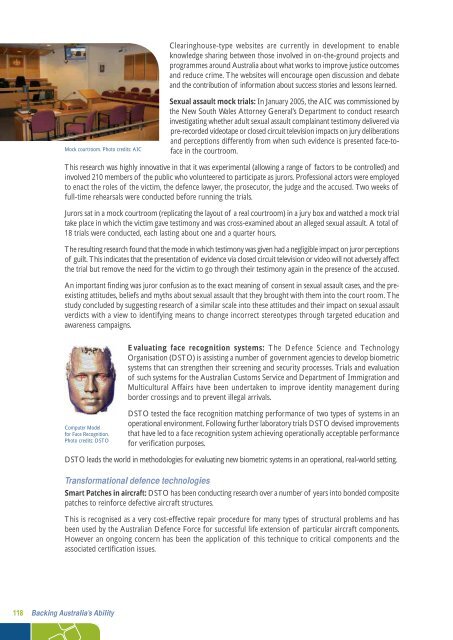The Australian Government's Innovation Report
The Australian Government's Innovation Report
The Australian Government's Innovation Report
You also want an ePaper? Increase the reach of your titles
YUMPU automatically turns print PDFs into web optimized ePapers that Google loves.
Clearinghouse-type websites are currently in development to enable<br />
knowledge sharing between those involved in on-the-ground projects and<br />
programmes around Australia about what works to improve justice outcomes<br />
and reduce crime. <strong>The</strong> websites will encourage open discussion and debate<br />
and the contribution of information about success stories and lessons learned.<br />
Mock courtroom. Photo credits: AIC<br />
Sexual assault mock trials: In January 2005, the AIC was commissioned by<br />
the New South Wales Attorney General’s Department to conduct research<br />
investigating whether adult sexual assault complainant testimony delivered via<br />
pre-recorded videotape or closed circuit television impacts on jury deliberations<br />
and perceptions differently from when such evidence is presented face-toface<br />
in the courtroom.<br />
This research was highly innovative in that it was experimental (allowing a range of factors to be controlled) and<br />
involved 210 members of the public who volunteered to participate as jurors. Professional actors were employed<br />
to enact the roles of the victim, the defence lawyer, the prosecutor, the judge and the accused. Two weeks of<br />
full-time rehearsals were conducted before running the trials.<br />
Jurors sat in a mock courtroom (replicating the layout of a real courtroom) in a jury box and watched a mock trial<br />
take place in which the victim gave testimony and was cross-examined about an alleged sexual assault. A total of<br />
18 trials were conducted, each lasting about one and a quarter hours.<br />
<strong>The</strong> resulting research found that the mode in which testimony was given had a negligible impact on juror perceptions<br />
of guilt. This indicates that the presentation of evidence via closed circuit television or video will not adversely affect<br />
the trial but remove the need for the victim to go through their testimony again in the presence of the accused.<br />
An important finding was juror confusion as to the exact meaning of consent in sexual assault cases, and the preexisting<br />
attitudes, beliefs and myths about sexual assault that they brought with them into the court room. <strong>The</strong><br />
study concluded by suggesting research of a similar scale into these attitudes and their impact on sexual assault<br />
verdicts with a view to identifying means to change incorrect stereotypes through targeted education and<br />
awareness campaigns.<br />
Evaluating face recognition systems: <strong>The</strong> Defence Science and Technology<br />
Organisation (DSTO) is assisting a number of government agencies to develop biometric<br />
systems that can strengthen their screening and security processes. Trials and evaluation<br />
of such systems for the <strong>Australian</strong> Customs Service and Department of Immigration and<br />
Multicultural Affairs have been undertaken to improve identity management during<br />
border crossings and to prevent illegal arrivals.<br />
Computer Model<br />
for Face Recognition.<br />
Photo credits: DSTO<br />
DSTO tested the face recognition matching performance of two types of systems in an<br />
operational environment. Following further laboratory trials DSTO devised improvements<br />
that have led to a face recognition system achieving operationally acceptable performance<br />
for verification purposes.<br />
DSTO leads the world in methodologies for evaluating new biometric systems in an operational, real-world setting.<br />
Transformational defence technologies<br />
Smart Patches in aircraft: DSTO has been conducting research over a number of years into bonded composite<br />
patches to reinforce defective aircraft structures.<br />
This is recognised as a very cost-effective repair procedure for many types of structural problems and has<br />
been used by the <strong>Australian</strong> Defence Force for successful life extension of particular aircraft components.<br />
However an ongoing concern has been the application of this technique to critical components and the<br />
associated certification issues.<br />
118 Backing Australia’s Ability












![[Tam] Uygula[ya] - Bilim, Teknoloji ve Ä°novasyon Politikaları TartıÅma ...](https://img.yumpu.com/36820041/1/184x260/tam-uygulaya-bilim-teknoloji-ve-anovasyon-politikalara-tartaama-.jpg?quality=85)



